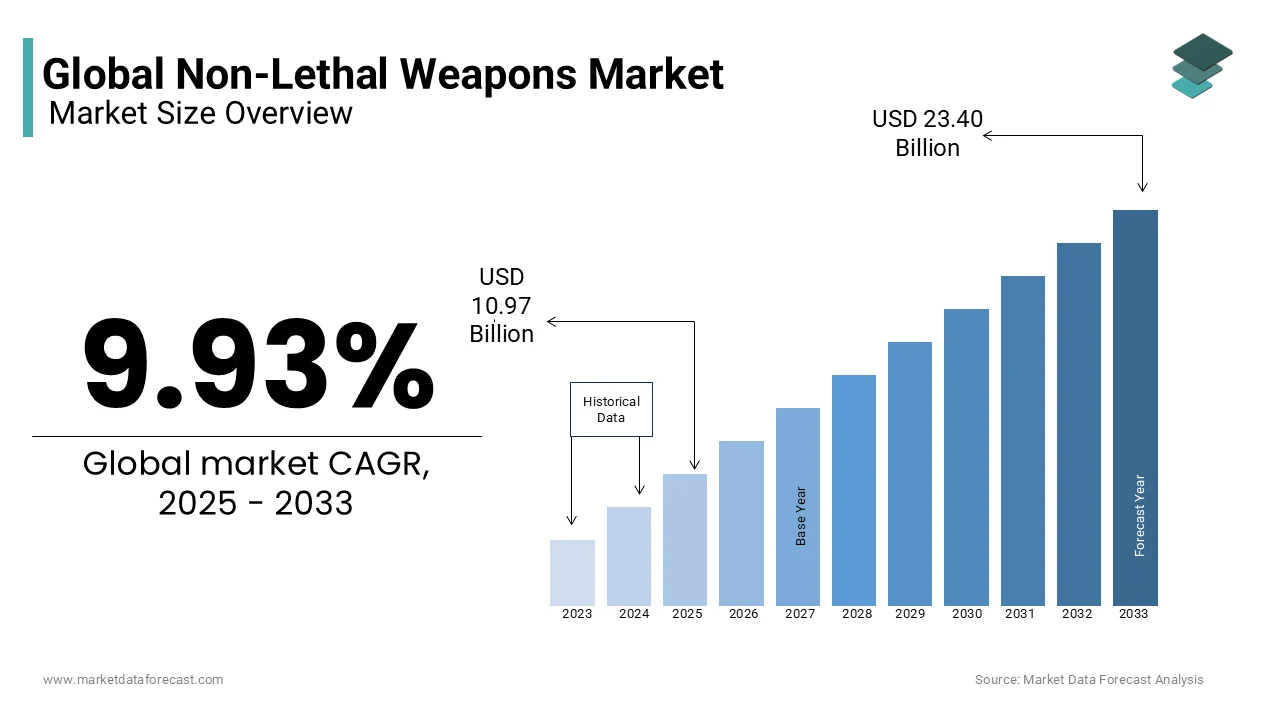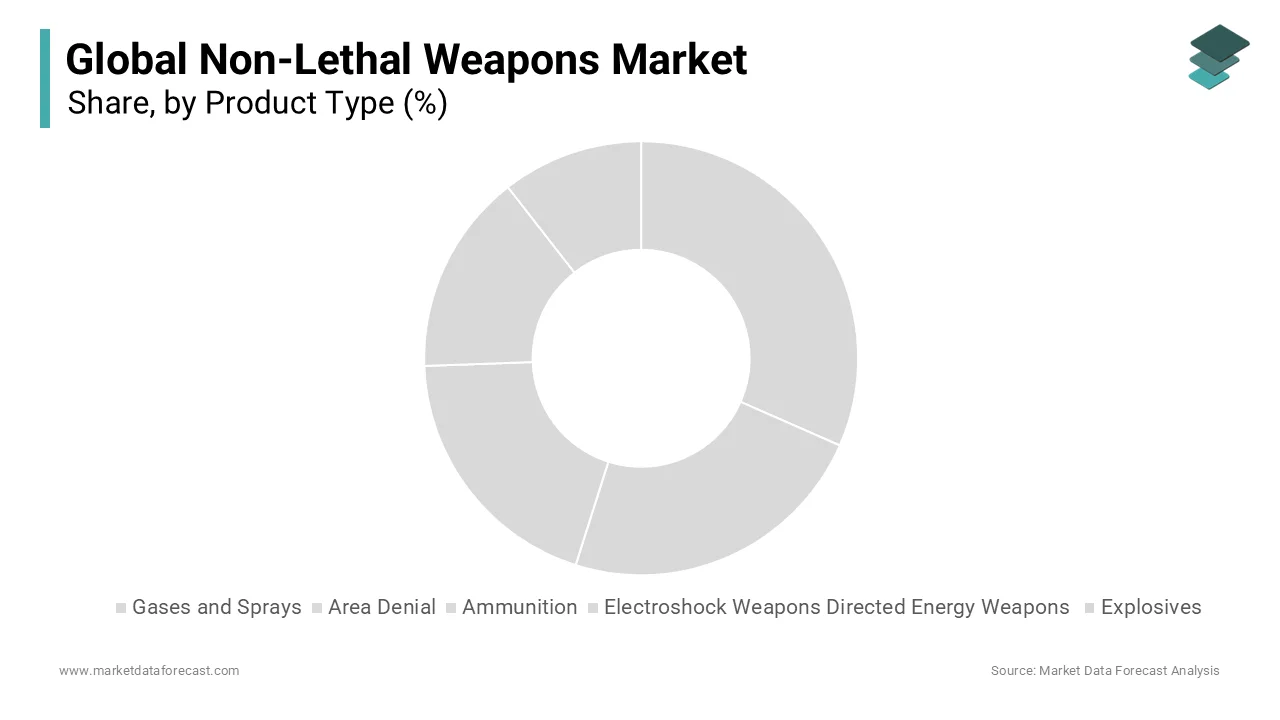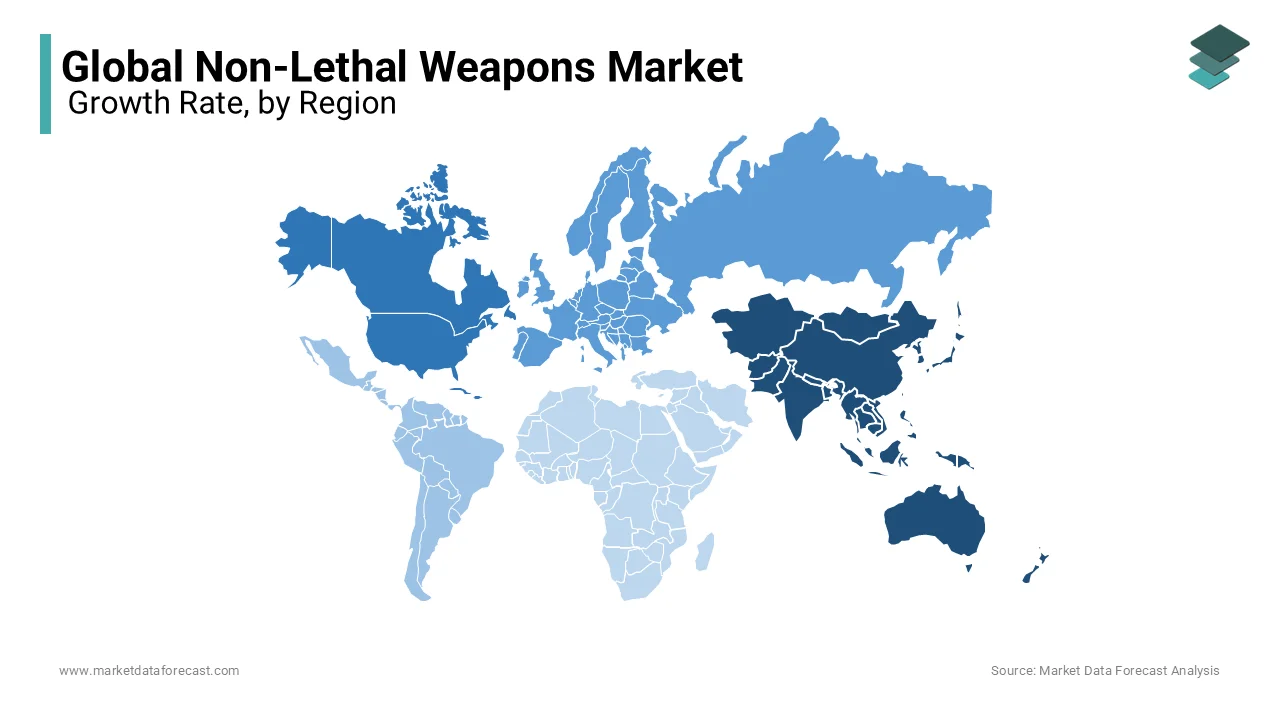Global Non-Lethal Weapons Market Size, Share, Trends, & Growth Forecast Report By product type (Gases and Sprays, Area Denial, Ammunition, Electroshock Weapons, Directed Energy Weapons, and Explosives), Technology (Mechanical & Kinetic, Electromagnetic, chemical, and others), End-User (Law Enforcement, and Military), and Region (North America, Europe, Asia Pacific, Latin America, and Middle East & Africa), Industry Analysis From 2024 to 2033
Global Non-Lethal Weapons Market Size
The global non-lethal weapons market size was valued at USD 9.98 billion in 2024. The global market size is predicted to grow at a CAGR of 9.93% from 2025 to 2033 and be worth USD USD 23.40 billion by 2033 from USD 10.97 billion in 2025.

The non-lethal weapons market is predicted to become an important part of law enforcement and asymmetric warfare over the next six years. Non-lethal weapons are designed to disable people and equipment without injuring them. They help reduce fatalities, permanent injuries to employees, and unintended property damage in the targeted area or environment. They also assist in resolving the expansion of force situations by directly impacting personnel and giving psychological impacts. As a result, they're widely used for military policing tasks like crowd control and dispersal, defending convoys and other forms of route control, transporting or guarding prisoners of war, and maintaining security details or guard duties.
MARKET DRIVERS
Non-lethal weapons have effectively replaced traditional weapons such as guns, grenades, and other technology-advanced solutions. Non-lethal weapons are growing due to rapid technological advancements. Moreover, there is a significant demand for non-lethal weapons technologies such as electromagnetic weapons, laser interdiction systems, multi-flash bangs, active denial weapons, and other non-lethal weapons technologies, which are further responsible for the non-lethal weapons market's growth. The development of non-lethal weapons has been supported by government-funded research and innovative organizations. Innovation accounts for a significant amount of a company's revenue. As a result, the non-lethal weapons market is expected to grow during the forecast period. In addition, non-lethal weapons, such as pepper sprays, have been created to help women fight against crime. This element also supports the market's growth.
MARKET RESTRAINTS
Non-lethal weapons can nonetheless cause injury, regardless of their design aim. This is especially true for technologies that interact with sufficiently sensitive body parts, such as kinetic munitions used on the head, neck, eyes, stomach, and urogenital regions. As a result, some analysts consider "non-lethal" a misnomer and suggest characterizing them as "less lethal." At the same time, other sources define "non-lethal" as minimizing the likelihood of creating fatalities or lasting damage without requiring zero probability. Furthermore, the impacts have always lasted for a short time because the design objective is to avoid/minimize persistence. As a result, some effects may be transient, while others may last for a certain amount of time. Therefore, these factors tend to restrain the growth of the global non-lethal weapons market.
REPORT COVERAGE
|
REPORT METRIC |
DETAILS |
|
Market Size Available |
2024 to 2033 |
|
Base Year |
2024 |
|
Forecast Period |
2025 to 2033 |
|
CAGR |
9.93% |
|
Segments Covered |
By Product Type, Technology, End-User, and Region |
|
Various Analyses Covered |
Global, Regional & Country Level Analysis, Segment-Level Analysis, DROC, PESTLE Analysis, Porter’s Five Forces Analysis, Competitive Landscape, Analyst Overview of Investment Opportunities |
|
Regions Covered |
North America, Europe, APAC, Latin America, Middle East & Africa |
|
Market Leaders Profiled |
The Safariland Group, Lamperd Less Lethal Inc., Textron systems, Nonlethal Technologies, BAE Systems Plc., Taser International, The Boeing Company, Pepper Ball Technologies Inc., ISPRA by Ei Ltd., Rheinmetall, CADRE HOLDINGS INC., and others |
SEGMENTAL ANALYSIS
By Product Type Insights
Ammunition holds the most significant global non-lethal weapons market share in the upcoming years based on product type. The market for the non-lethal ammunition segment is highly fragmented, with only a few companies offering traditional non-lethal weapons. There are various manufacturers in the United States that have been funded and maintained by the government and can meet both short- and long-term demands. Therefore, as the supply chain is localized and supported by government finance and logistics, they may boost concentrate on certain ammunition and increase production rate on short notice.

By Technology Insights
Based on technology, the chemical segment is estimated to have the highest market share revenue in 2024, primarily because of the increasing demand for non-lethal chemical weapons such as tear gas, aerosols, smoke grenades, and chemical projectiles by law enforcement agencies around the world.
By End-User Insights
The military segment is anticipated to have the highest non-lethal weapons market share during the forecast period. As the military's responsibility in policing civilian populations has grown, the role of the armed forces or military has shifted dramatically. Military units are involved in ongoing international wars that have direct contact with civilian people in today's world. In addition, soldiers serving on humanitarian missions are subject to tight engagement rules. In addition, militaries are ready to operate in MOOTW (Military Operations Other Than War) scenarios in which lethal force is prohibited. With less-lethal weapons such as rubber bullets, batons, foam, bean bag rounds, and sponges failing to achieve their goals, there is an increasing desire for weapons that may achieve pain compliance without the risk of mortality.
REGIONAL ANALYSIS
The Asia-Pacific is expected to have the highest CAGR of 8.5 % during the forecast period. The need for less-lethal weaponry has intensified in recent years, as tensions in Kashmir have risen and protests have erupted across India. In addition, occasional riots and civil unrest, such as demonstrations and protests in Eastern Chinese cities, often linked with labor-related, environmental, and educational issues, have led to the use of non-lethal ammunition by police forces, which, collectively, may have a positive impact on the market's growth.

North America is predicted to hold the highest market share during the forecast period. This is because it experienced increased violence-related incidents, and law enforcement agencies' demand for non-lethal weapons is driving the non-lethal weapons market. Furthermore, growing concerns about personal safety may lead to an increase in the market for non-lethal weapons in the United States. In addition, the US Department of Defense (DoD) is now concentrating on creating non-lethal weaponry to reduce the likelihood of fatalities and permanent damage.
In the non-lethal weapons market, the United Kingdom currently had the largest market share during the foreseen period. This is primarily due to the development of new non-lethal weapons that are effective and safe in combating the threat. For example, to assist soldiers in Afghanistan in irritating and deterring prospective opponents, the UK Army developed the Variable Kinetic System (VKS), a new non-lethal weapon. The weapon fires Paintball-like projectiles packed with a hot pepper solution. Furthermore, as compared to traditional firearms, most law enforcement and police officers carry less-lethal weapons such as Tasers, batons, and mace spray canisters.
KEY MARKET PARTICIPANTS
Companies playing a major role in the global non-lethal weapons market include The Safariland Group, Lamperd Less Lethal Inc., Textron systems, Nonlethal Technologies, BAE Systems Plc., Taser International, The Boeing Company, Pepper Ball Technologies Inc., ISPRA by Ei Ltd., Rheinmetall and CADRE HOLDINGS INC.
RECENT HAPPENINGS IN THE MARKET
- On October 18, 2021, a company in Uttar Pradesh created non-lethal weapons for the Army to employ in Galway. In addition, a Noida-based company has developed non-lethal weapons for security forces based on traditional Indian weapons used in man-to-man combat.
- Taser International declared that their non-lethal weapons are ready for the Indian security forces to deal with the Army's club in China.
MARKET SEGMENTATION
This research report on the global non-lethal weapons market has been segmented and sub-segmented based on the product type, technology, end-user, and region.
By Product Type
- Gases and Sprays
- Area Denial
- Ammunition
- Electroshock Weapons Directed Energy Weapons
- Explosives
- Others
By Technology
- Mechanical & Kinetic
- Electromagnetic
- Chemical
- Others
By End-User
- Law Enforcement
- Military
By Region
- North America
- Asia-Pacific
- Europe
- Latin America
- Middle-East-America
Frequently Asked Questions
What are the primary drivers of growth in the non-lethal weapons market?
The primary drivers include increasing civil unrest and protests, rising demand for crowd control measures, advancements in technology, and growing adoption by law enforcement agencies globally.
How are governments influencing the non-lethal weapons market?
Governments are influencing the market through procurement policies, regulatory frameworks, and funding for research and development. Increased defense and law enforcement budgets in various countries also contribute to market growth.
How is technology innovation impacting the non-lethal weapons market?
Innovations in technology are leading to more effective and safer non-lethal weapons. Developments such as advanced taser technology, improved delivery systems for pepper spray and tear gas, and the use of artificial intelligence in surveillance and control systems are significantly impacting the market.
What are the projected trends for the non-lethal weapons market in the next decade?
Projected trends include increased adoption of non-lethal weapons by civilian sectors, technological advancements leading to more sophisticated and versatile non-lethal options, and a growing emphasis on the ethical use and regulation of these weapons to address public safety and human rights concerns.
Related Reports
Access the study in MULTIPLE FORMATS
Purchase options starting from $ 2500
Didn’t find what you’re looking for?
TALK TO OUR ANALYST TEAM
Need something within your budget?
NO WORRIES! WE GOT YOU COVERED!
Call us on: +1 888 702 9696 (U.S Toll Free)
Write to us: [email protected]